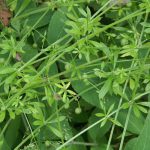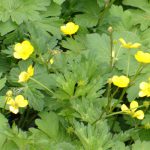Blackberry
Rubus fructicosus

Known as the bramble in Scotland, the blackberry is often unwelcome in your garden due to its horrible jaggy stems. Don’t let it take hold – it will send up multiple shoots which root at the tips. There is a deep, tough woody root. You may want to keep some in a mixed hedge due to its fruits but be warned to keep it under control. Bramble is a scrambling species, which produces arching thorny stems which can grow up to 2.5m in length. Fruits appear from September onwards and are first green in colour turning red and near-black fruits as they ripen.
Leaves
The leaves have jagged edges with five to seven oval leaflets.

Flowers
Flowers are present from May to September, the delicate flowers are white or pinkish in colour.

Preferred Habitat
It is native in a range of natural and man-made habitats. Bramble occurs throughout Britain in hedgerows, scrub, woodland and wasteland. It can be a problem weed in gardens. Brambles will thrive in most soils and are shade tolerant.
Weed Control
The roots are killed by frequent cultivation. Cutting the stems at or near ground level stimulates the formation of suckers from the lateral roots. It is a perennial with tough spreading roots which must be dug out and even then it is difficult to get all of it as it spreads so far.
Not Just a Weed
Although bramble is a weed in many situations, it is valued for its edible fruit and is often found in cultivation. The leaves have medicinal uses and the roots yield an orange dye.
The leaves and the bark of the root of the bramble plant contain tannin while the fruit contains pectin, albumen, citric and malic acids, anthocyanins which have powerful antioxidant properties and help, along with those of vitamin K, C and E and the polyphenols present in blackberries, to make the berry one of the top fruits in the antioxidant stakes…They also contain calcium, manganese, iron, phosphorous and magnesium, potassium, zinc, copper and traces of selenium.














